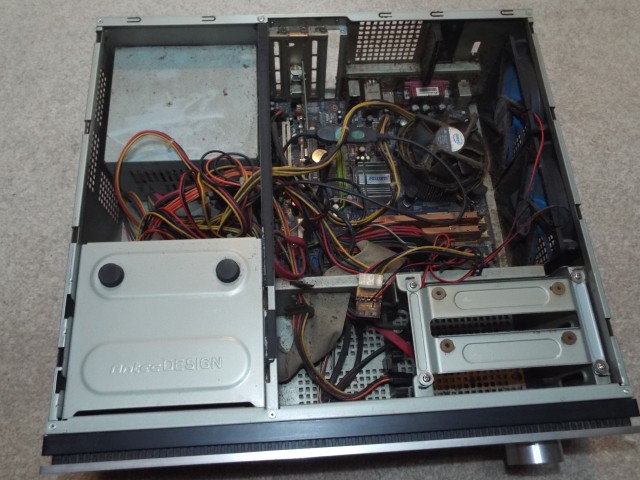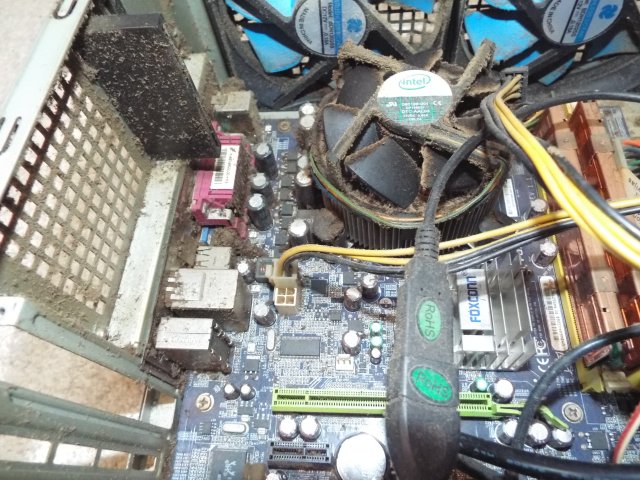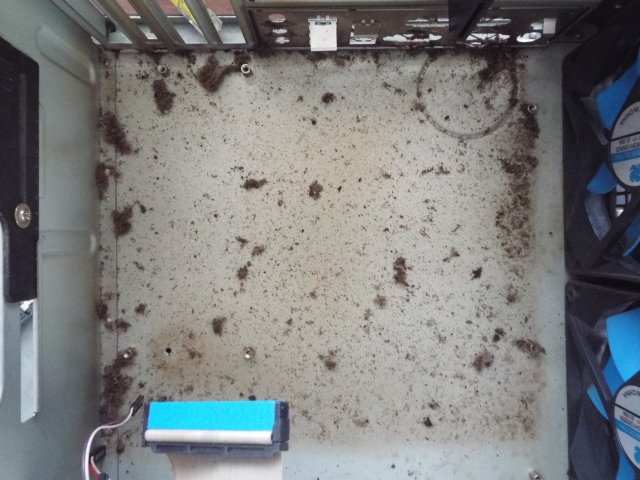|
-
Acquiring my Antec Fusion -
- Initial clean and test -
- Installing Windows -
- Front panel display / volume
issues -
- Things fail -
[19 February 2022] I
acquired my Antec Fusion case
off ebay. At the time of
purchase it was housing a
system, all pretty old now but
complete with everything except
a hard drive and operating
system to make it work.
I
got it for what I consider to be
a good price considering I
intended to just resell the case
to make a profit, and then see
what was what with the parts
inside that were included,
although the whole thing was
sold as "spares / repairs" so I
didn't hold out high hopes.
Initial clean and test...
The
system needed a good clean out
as it was full of nicotine-ladened
dust (the worst kind). I also
spotted at least one motherboard
capacitor that was bulging.


I
inspected and cleaned out inside
the PSU too* but thankfully
there was no sign of any failing
capacitors in there.
| *Warning, do not meddle inside PSUs unless
you know what you are doing as they can contain high voltages. |
After spending some time
cleaning out the dust I plugged
things back in and switched the
system on for the first time...
*BANG*... just kidding, there
was no bang, the system just
calmly whirred into life; even
the two 120mm fans were still
operating quietly.
Installing stuff...
I
installed Windows 10 on an SSD
to test things further and that
went well.
There was an included 'TV
Capture Card' and the drivers
were automatically downloaded by
Windows and installed as
'Philips SAA713X, Hybrid Capture
Device'. I have to wonder what
software was originally included
with this and if it is still
available or what to install
instead to make use of it (not
that I intend to use it myself).
Motherboard drivers could be
problematic though; it is a
Foxconn 945GZ7MC-RS2H. I avoided
using the onboard graphics
(limed to VGA and 2MB I
believe), and opted to install a
dedicated graphics card, partly
also to see if the PSU could
cope.
There is 2GB RAM installed (with
Akasa-branding on the heat
spreaders) and
one problem I discovered was
that all but one of the plastic
levers on the RAM slots were
broken off... and that one I
broke off. But it turns out 2GB
of PC2-533 RAM is the max.
apparently, so what's there can
stay where it is; I'd prefer 4GB
for Windows 10, but it can work
on 2GB.
Regarding the PSU, it's an Antec
branded one also and proved
capable [for now...].
Front panel display...
Connecting up the case's front
panel display and getting that operational proved to be tricky.
There was a USB lead to connect to a header and I noticed in the
Device Manager that this presented an Unknown device. Researching
further I found that "iMon" software was required, but the first
iteration I tried of this, while it installed the drivers, then
presented me with the following error:

"VFD H/W installed in this system is for ANTEC VFD, NOT for iMON."
Thankfully, as forums
suggested, installing a different version resolved this.
The display works; it
cycles through various outputs as per the software, and (showing
its age here) will display information from WinAmp (which I duly
installed to test out). Apparently it should show equalizer
graphics but for me it just cycled the track number and title. The
main issue is that the large volume control knob doesn't operate
the volume. When it is rotated the display says '0 Volume', which
implies the system it at least recognising the input. I don't know
if this is a software thing or an actual fault with the knob. Maybe
some grime got in to the contacts. I did dismantle it a little to
see, but couldn't get far with just removing screws, and I can't
see that De-oxit would get in anywhere helpful. I might give that a
try as a last resort. The large knob that the case features is
rather ridiculous if it doesn't work.
Perhaps driver issues
are the issue... there still remains an 'Unknown device' and the
sound output is showing as Digital Audio S/PDIF. I've tried
downloading various audio drivers with no change.
Speaking of the large
knob; the overall aesthetic of the front of the case is pleasing
to me and I'm considering that it would probably look good coupled
with two old Sony amplifiers I have. Since I've been playing
around with this case I'm tempted to do more with it rather than
just sell it...
-
Could I fit a 2 x
120mm AIO liquid cooler (minus the fans) and make a super quiet
system? I have one that might fit.
-
I would consider a
passively cooled graphics card; I'm visualising one that has a
large heatsink that wraps round the PCB since this case has poor
GPU cooling.
[20 February 2022] The
next day I decided I would install Windows 7 on the system; this would enable
me to check the sound driver issue since the drivers would
surely work with 7. This would also enable me to check the
volume knob again.
I had just finished transferring the
files I had downloaded onto a memory stick ready to wipe over
everything on the SSD with Windows 7, when... *BANG*... no it
didn't really do that... but it might of... The computer wouldn't
switch back on for me to install the OS. Somehow, even though I'd
had the computer running under load for some days (running
Einstein@home) the PSU had now decided to give up... silently.
Very weird (perhaps it serves me right for doing yesterday's fake
*BANG*.... I'll add the PSU to my small pile of "To Fix Later" and
resort to using another on my next attempt...
Sadly that attempt also failed; not
only had the PSU given up, the motherboard wasn't powering up with
a replacement.
I decided to remove the motherboard to
investigate further. Here's the mess I found under it...

I really should have done that to
begin with.
I determined that those capacitors I
had noted were bulging were the most likely failure point. I took
a closer look at them to determine what replacements I needed. I
started reading the details on them and got confused why the four
tall brown ones all had the same rating when they were clearly
different sizes...

The reason being, they had
expanded/blown their tops so much that some looked taller than
others - I'd never seen any failed capacitors look quite like that
before! I'm surprised I had this board working at all... I'm also
suspecting that the state of these capacitors lead to PSU failing.
For now I have ordered some
replacement capacitors, four tall ones, and six of the small ones
that surround the CPU. They're coming from China, so will take a
while to arrive.
[UPDATE] Sadly my efforts to replace
the capacitors proved to be unsuccessful; the board would still
not POST. I had struggled to remove the old capacitors and it may
have been that I damaged the board or there was some other issue.
[Back
to Top]
|